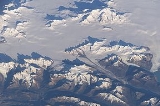
O'Higgins Glacier
Encyclopedia
O'Higgins Glacier is a glacier
located in Bernardo O'Higgins National Park
, Chile
. It is one of the principal glaciers of the Southern Patagonian Ice Field
. The summit of the active Lautaro
volcano is the top of the accumulation zone
of the glacier. The bulk of the glacier is part of the icefield plateau. It flows eastward into O'Higgins Lake and is about 2 km (1.2 mi) wide at the terminus.
The glacier is also known to be melting caused by Global Warming
.
Glacier
A glacier is a large persistent body of ice that forms where the accumulation of snow exceeds its ablation over many years, often centuries. At least 0.1 km² in area and 50 m thick, but often much larger, a glacier slowly deforms and flows due to stresses induced by its weight...
located in Bernardo O'Higgins National Park
Bernardo O'Higgins National Park
Bernardo O'Higgins National Park is the largest of the protected areas in Chile, covering an area of in both the Aisén and Magallanes and Antártica Chilena regions. The park is named after General Bernardo O'Higgins, first head of state of the Republic of Chile...
, Chile
Chile
Chile ,officially the Republic of Chile , is a country in South America occupying a long, narrow coastal strip between the Andes mountains to the east and the Pacific Ocean to the west. It borders Peru to the north, Bolivia to the northeast, Argentina to the east, and the Drake Passage in the far...
. It is one of the principal glaciers of the Southern Patagonian Ice Field
Southern Patagonian Ice Field
The Southern Patagonian Ice Field , located at the Southern Patagonic Andes between Argentina and Chile, is the second largest contiguous extrapolar extent of ice in the world...
. The summit of the active Lautaro
Lautaro (volcano)
Lautaro Volcano is an active ice-covered stratovolcano located in Chilean Patagonia, in the northern part of the Southern Patagonian Ice Field. Its summit rises more than above the average surface of the ice cap plateau. It is the tallest mountain in Bernardo O'Higgins National Park and in its...
volcano is the top of the accumulation zone
Accumulation zone
On a glacier, the accumulation zone is the area above the firn line, where snowfall accumulates and exceeds the losses from ablation, . The annual Glacier equilibrium line separates the accumulation and ablation zone annually...
of the glacier. The bulk of the glacier is part of the icefield plateau. It flows eastward into O'Higgins Lake and is about 2 km (1.2 mi) wide at the terminus.
The glacier is also known to be melting caused by Global Warming
Global warming
Global warming refers to the rising average temperature of Earth's atmosphere and oceans and its projected continuation. In the last 100 years, Earth's average surface temperature increased by about with about two thirds of the increase occurring over just the last three decades...
.

